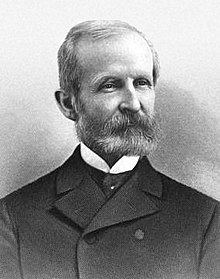Name John Harlow | Role Physician | |
 | ||
Born November 25, 1819 ( 1819-11-25 ) Whitehall, New York Occupation Physician, bank director Education Philadelphia School of Anatomy, Thomas Jefferson University | ||
Aidan - The Relation between Brain and Behaviour - Dr. John Martyn Harlow
John Martyn Harlow (November 25, 1819 – May 13, 1907) was an American physician primarily remembered for his attendance on brain-injury survivor Phineas Gage, and for his published reports on Gage's accident and subsequent history.
Contents
Harlow was born in Whitehall, New York on November 25, 1819. He studied at Philadelphia School of Anatomy and graduated from Jefferson Medical College, Philadelphia in 1844. His practice in Cavendish, Vermont, near which Gage's accident occurred in 1848, brought Gage under his care. In 1857 he left Cavendish due to poor health, and spent three years traveling and studying in Minnesota and Philadelphia before setting up a practice in Woburn, Massachusetts and joining the Massachusetts Medical Society on December 17, 1861.
His first paper on Gage appeared in Boston Medical and Surgical Journal in late 1848; a short follow-up note appeared early the next year. Almost twenty years later, in 1868, he published a final paper recounting what he had been able to learn about the subsequent history of his patient (who died in 1860), and presenting psychological changes in Gage which, presumably, were sequelae of the accident. In one of the most memorably strange examples ever of dogged long-term medical followup, Harlow, having "trac[ed Gage] in his wanderings over the greater part of this continent" (by which he meant South as well as North America, Gage having spent seven years in Chile before continuing to California) had even obtained Gage's skull for use in preparing the paper.
In his later years he was a bank and railroad director. He was highly active in civic affairs such as city health commissions, was a local medical official during the Civil War, and was elected to both the Massachusetts State Senate and the Massachusetts Governor's Council.
On Harlow's death The New York Times (May 14, 1907) called him "one of the oldest and most prominent physicians and surgeons of New England". He left most of his substantial wealth to charity, for example endowing a ward for the poor at Massachusetts General Hospital and a book fund at Woburn Memorial High School's library, which is named for him.
